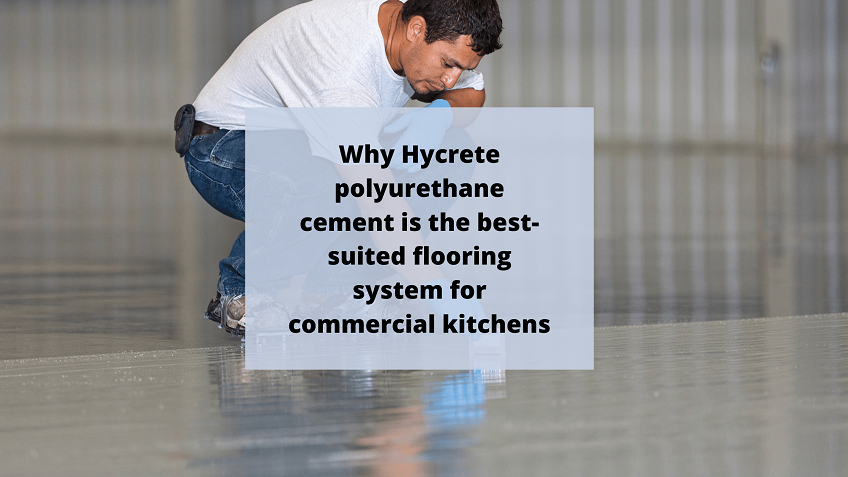
Purpose of Hycrete Polyurethane Cement
Commercial kitchens have high foot traffic and are cleaned on a regular basis, so they need to be tough and durable. Using the wrong product on you commercial floor can cause cracking, chipping, and flaking, so, investing in the correct type of flooring will save you time and money in the future. This article discusses which commercial kitchen flooring system best suits your needs. Lets begin.
Why is Hycrete Polyurethane Cement the Best Commercial kitchen cement?
Hycrete polyurethane cement is used as a topcoat on concrete floors in high-traffic areas; it works best in high-temperature, acid-resistant environments. It is resistant to phosphoric acid, sanitizing chemicals like peroxyacetic acid, and food acids like phosphoric acid.
Polyurethane cement is tough, long-lasting and impact-resistant. This ensures the product’s strength, durability, and long-term performance. Heavy machinery or clumsy chefs can’t harm the Hycrete system. It can also withstand acids, fats, and cleaning solutions, all common in commercial kitchens. Your flooring will not last very long if it is not resistant to these substances.
Heat and Shock Resistance
Extreme temperature changes in commercial kitchens necessitate a specially designed flooring system. High temperatures and thermal shock are no match for the Hycrete polyurethane cement system in commercial kitchens.
Slip Resistance
A safe workplace is critical to any business’s success. Commercial kitchen flooring systems like Hycrete must meet safety and health standards. A well-designed commercial kitchen flooring system is used daily to reduce or eliminate slips, trips, and falls.
Commercial kitchen floors must be easy to clean. For example, strict food safety regulations in commercial kitchens prevent bacteria from growing on floors. Bacteria, fungi, mold, and mildew are all resistant to Ultra-Fresh antimicrobial technology.
HACCP Australia has approved Hycrete as a suitable floor surfacing material in HACCP-compliant food and beverage facilities. The Australian Paint Approval Scheme, a government-run program, has also approved Hycrete.
Versatility
Colored Hycrete polyurethane cement is available for those who value appearance and performance. It’s a visually appealing flooring system that appeals to many aesthetic tastes. Polyurethane floors are durable and suitable for commercial kitchens. Worldwide, commercial kitchen flooring is rapidly replacing residential flooring.
Applications
Polyurethane sealants are commonly used for:
Scratch and stain-resistant floors for high traffic areas
Decorative concrete includes colored, stamped, and exposed aggregate.
There are concrete counters.
Polyurethanes should not be applied to wet surfaces in most cases. A chemical reaction’s foaming and bubbling are normal. They prevent moisture from escaping concrete surfaces in some cases, like driveways.
How to Begin
These sealers require more frequent attention than acrylic sealers due to their multi-component nature. Avoid using a garden pump-up sprayer for a thin, even spray pattern when using water-based polyurethanes. Instead, use an airless sprayer with low volume and high pressure.
What is urethane cement, and how does it work?
Polymer is used as a filler and binder in the construction industry. Urethane cement is the binder in polymer concrete. Urethane cement can be used to coat floors. The coatings are known for their chemical and temperature resistance.
Is epoxy a better alternative to polyurethane?
Epoxy flooring is less elastic and flexible than elastomeric polyurethane floor coatings. Polyurethane coatings are standard in high-traffic areas like multi-story parking garages and parking lots due to their scratch and damage resistance.
Is polyurethane a versatile sealant?
It has an oil and water base, unlike polyacrylic. Choosing between oil-based and waterborne sealants isn’t as simple as it seems. Kitchen tables and hardwood floors should be finished with oil-based polyurethane for the best results.
These are unfamiliar terms. These include urethane and epoxy. Epoxy is a more durable, non-moving material, but it is more expensive. Even though epoxy is a tough material, it will crack if moved frequently. Easy to work with urethane. Urethane is ideal for structures that expand and contract with the seasons.
How many polyurethane coats should you apply?
Before you apply the second coat be sure to vacuum and clean the surface using a tack cloth, this will get rid of any dust or dirt. Repeating these steps will help reinforce your defenses. Hard-to-reach surfaces such as floors and walls should be painted three coats thick.
